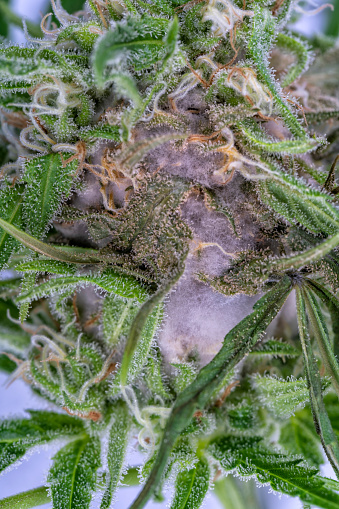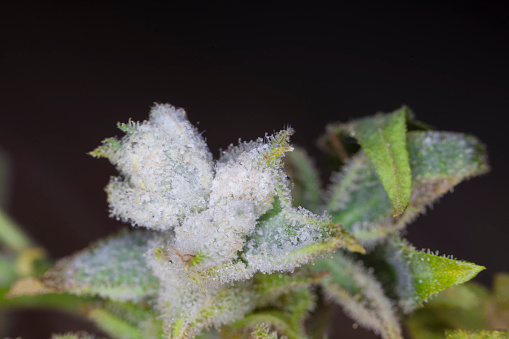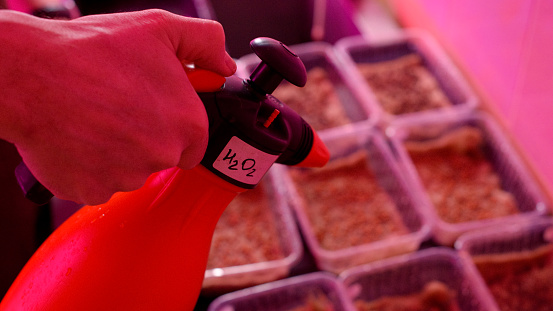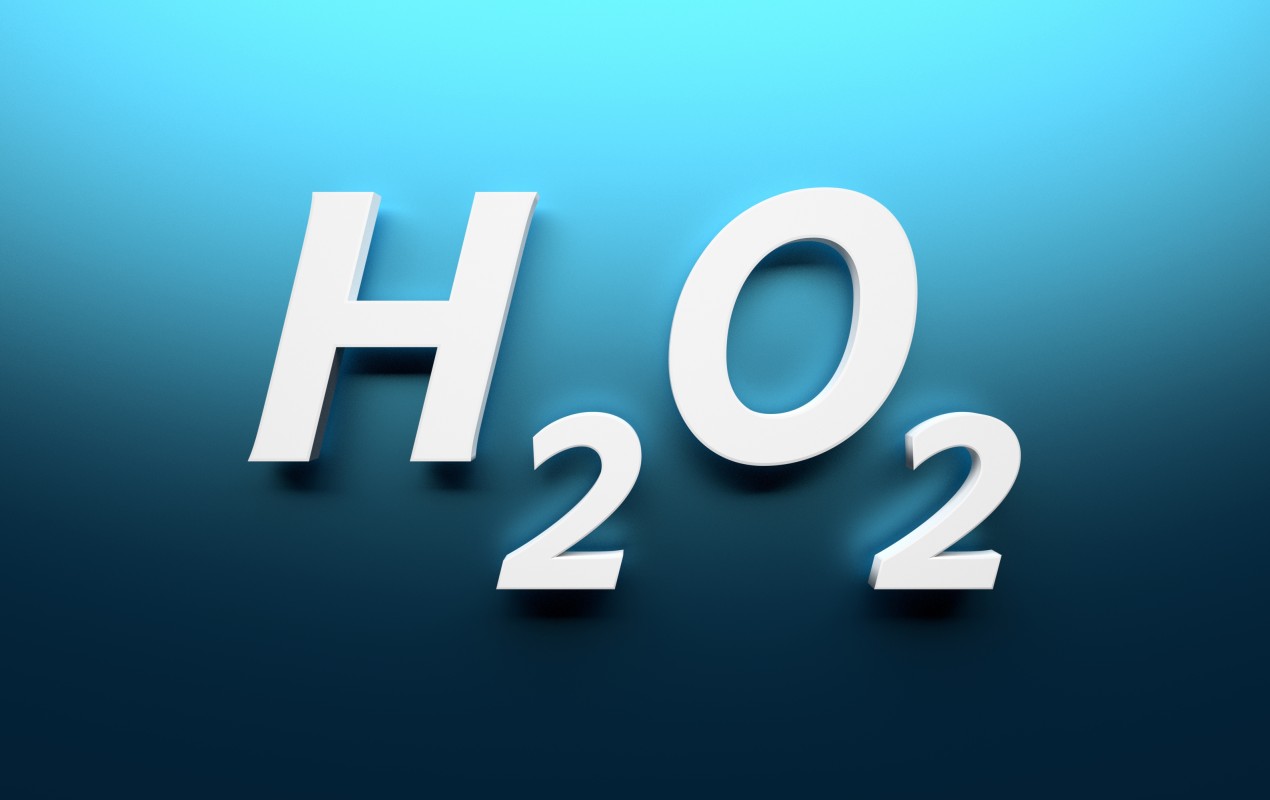As a beginner grower, you often stumble on unconventional growing advice, and most times you never know what to do. One of such unconventional pieces of advice is spraying hydrogen peroxide on buds.
Spraying hydrogen peroxide or anything on your already harvested buds sounds so wrong because the bud is ready for consumption, and you don’t want to contaminate it. Purists like me, and most growers I know want their buds fresh; no smell of pesticides or some nasty-smelling organic pest control liquid.
Growing plants, on the other hand, are different because they’re still rooted to the ground and have the time to expel compounds that could potentially affect your buds.
Still, using hydrogen peroxide to deal with post-harvest mold attacks won’t harm you.
Or to fairly state, if there’s any harm, it won’t be as a result of using hydrogen peroxide on your buds since it breaks down into harmless compounds–water and oxygen.
While it’s true that plants need to remove harmful compounds from insecticides before they’re consumed, hydrogen peroxide doesn’t leave any harmful residue on your plants.
Perhaps, it is because of its safety that most gardeners have found numerous uses for hydrogen peroxide in the garden and their homes in general.
You want to learn how spraying your buds with hydrogen peroxide helps them weather the storms of the growth cycle? Read on to find out.
Table of Contents
Why Does Spraying Hydrogen Peroxide On Cannabis Plants Help?
I’ve heard growers speak wonderful things about spraying hydrogen peroxide on buds. As a novice grower you’d want to know what makes hydrogen peroxide special. Right?
Well, hydrogen in isolation doesn’t help your plant in any way, but the magic happens as it breaks down. In its natural state, hydrogen peroxide is denoted in the following chemical identity, H2O2 which is a combination of water (“H20”) and oxygen (“02”). Hydrogen peroxide breaks down to form water and oxygen.
The extra oxygen atom produced as a byproduct of the reaction is a free radical, and thus destroys organic bodies it gets in contact with, including the mold spores on your buds.
The extra oxygen atom is what gives magic to hydrogen peroxide.
Situations When Spraying Hydrogen Peroxide On Cannabis Helps
Hydrogen peroxide is commonly used in the making of pesticides and disinfectants. It is mostly safe given that most products contain no more than 35% concentration, which is then diluted to 1% or less when used as foliar spray.
Though regarded as one of the safest approaches to pest control, hydrogen peroxide is corrosive in higher concentrations, and will cause irritation on the skin— an indication that it might be unsafe for your plants in higher concentrations.
The good news is, most hydrogen peroxide products you get from drug stores contain up to 3% concentration. Thus when you follow the instructions on the label, they pose no harm to your plants.
Still, you shouldn’t be out here spraying hydrogen peroxide on weed plants when they need something else.
Think about it for a second, we’re talking about the same hydrogen peroxide in your medicine cabinet that you’ve been using to disinfect cuts and bruises. If it harms the germs and pathogens in cuts and wounds, you sure should use it with caution, especially in higher concentrations.
Hydrogen peroxide is useful in many little ways at home, but the garden is where you need its saving grace more.
As typical with other environments where plants grow, your weed grow room will be prone to pests like gnats and fungus, and dealing with them requires absolute speed and effectiveness. Fungal infestations, like mold or mildew can destroy your entire yield in a few days!
Your cannabis plants will thus need a fortress against these environmental hazards and a cure when they strike.
The use of hydrogen peroxide is widespread because it is one of the safest pest control methods on your plants.
Hydrogen peroxide is made from the same atoms that make water, in essence, it’s just water with an additional atom. The additional atom gives it its beneficial properties— the healing potency we tap into whenever we spray hydrogen peroxide on weed plants.
Here are the situations when spraying hydrogen peroxide on your buds will save the day;
Hydrogen peroxide for bud rot
Bud rot can wreak havoc in your whole grow room. Something that begins with one bud can speedily spread to other plants and without a quick response, you lose everything to the infestation.
Bud rot will begin in the buds, and will stay hidden. By the time you realize you have bud rot, it might be too late. If your plant has been affected by bud rot, you will need to move in haste to save whatever is left. Chop off the affected buds.
You can’t save them, and they’re no good. Besides they possess the threat of spreading the mold spores to the closest plants before consuming the entire grow room.
Once the buds get the bud rot, you can’t save them, but you can contain the spread of the mold spores to other parts of the plant by sterilizing the plant with a solution of half water and half 3% nitrogen peroxide. Hydrogen peroxide for bud rot helps you curb the spread of bud rot safely and inexpensively.

If you’re looking at a serious bud rot infestation, spraying the buds with hydrogen peroxide will not help eliminate the bud rot entirely, but will help contain the spread until you harvest the plants.
Though spraying hydrogen peroxide on your buds helps contain the spread of mold spores, you’re better off preventing the attack altogether. Bud rot is mostly a sign of higher humidity. Thus, dialing your humidity to the right level helps you keep your buds safe.
Invest in proper dehumidifiers if you grow in a humid climate. The investment is worth every penny as it shields you from spending more on mold control, and guarantees the quality of your buds at the end of the cycle.

Hydrogen peroxide for pest control
Hydrogen peroxide is a common ingredient in most disinfectant products, but it has also been approved for pest control. Hydrogen peroxide is useful at fighting microbes, bacteria, and fungi that might invade your cannabis plants.
The best thing about hydrogen peroxide as a pesticide is that it breaks down into water and oxygen. Thus doesn’t pose any risk to your cannabis plants when used in appropriate concentrations.
Over the counter pesticides made from hydrogen peroxide never contain more than 35% concentration, but even this is diluted to 1% or less before using it on the plants. Diluting it guarantees the safety of your plants.
Due to the general consensus on its safety as a pesticide, most growers use hydrogen peroxide for powdery mildew during flowering.
The cannabis plant is mostly vulnerable at the flowering stage when the blossoms become attractive to sapping insects and other pests, and using hydrogen peroxide helps keep the pests at bay without affecting your buds’ taste and aroma nor hurting the plant’s growth and nourishment.
Hydrogen peroxide can be used as a foliar spray, a dip for cuttings— especially when planting from clones, and as a soil treatment to get rid of gnats and bugs before planting.
Does hydrogen pose any risk to the environment when used as a pesticide?
Fortunately, pesticides that contain hydrogen peroxide don’t hurt the environment because hydrogen breaks down to water and oxygen, leaving no residue.
It’s the safety guarantee that makes hydrogen peroxide for powdery mildew during flowering a viable option. It will leave no residue in your buds, and thus doesn’t affect the quality of the buds— both taste and aroma.
Most growers are mindful of how the products they use affect the environment, and honestly, we should all be. Environmental conservation is a communal responsibility. You can be rest assured that using hydrogen peroxide won’t harm your plants if you follow label instructions.
Does Hydrogen Peroxide pose health risks to humans?
Whether a substance is harmful or not depends entirely on two things; it’s toxicity and the level of exposure an organism is to it. EPA checks toxicity and exposure data before approving pesticides and agricultural products for use.
Since hydrogen peroxide is used in low concentrations in pesticides, no harm to humans has ever been recorded. It also helps that it decomposes into water and oxygen, posing no risk to human health.
Besides, the FDA considers hydrogen peroxide a GRAS (generally recognized as safe), guaranteeing your safety. However when handling high concentrations of hydrogen peroxide, you should use protective equipment as it can be corrosive to the skin and irritating to the eyes.
Hydrogen peroxide for aerating the soil
Oxygen is an essential resource for plants. We all know that plants give off oxygen as a by-product of photosynthesis, but do you know how bad your plant’s roots need oxygen? Well, compact soils inhibit aeration, leaving the roots in a poor environment, craving oxygen.
Oxygen requirement at the roots should make you think a lot about hydrogen peroxide for plants, and why everyone mentions it as the perfect solution for root problems.
Hydrogen peroxide breaks down into water and oxygen. Thus, it is an effective way of enriching compact, oxygen-deprived soils.
In a study about the impact of hydrogen peroxide injection into the clayey soils though both subsurface and on-surface irrigation found that adding hydrogen peroxide into the soil increased oxygen content and improved the soil.
In this study, the researchers irrigated pepper plants with both 800ppm of hydrogen peroxide solution. Other plants received a boost of 600ppm of hydrogen peroxide solution.
They later compared the effect these two scenarios had on the compact, clayey soil. The soils that received the 800ppm concentration of hydrogen peroxide had improved soil-air concentration.
Though this research didn’t involve cannabis plants, it sure showed how using hydrogen peroxide for plants enriches the soil and improves your plant’s growth.
Poorly aerated soils become a host to many diseases—including root rot that might kill your plant. Thus, adding hydrogen peroxide aerates the soil, affording your plants a healthy growth.
Hydrogen peroxide for fungus gnats
Fungus gnats are the small flies that you sometimes spot on top of the soil and other grow mediums. They can also be spotted on rotting surfaces like compost and decaying plant stems.
The problem with fungus gnats is that they lay eggs, and unless you destroy them from the eggs level, they will continue infesting your grow mediums, laying eggs and consuming the organic matter in grow mediums, including your plant’s roots and leaves.

The eggs metamorphosize into larvae that will chew your plants as they grow, inhibiting their growth and exposing them to a whole world of horrible plant diseases.
It is worse when fungus gnats attack your plants at the seedling stage as they can chew the tender roots, inhibiting nutrient uptake by the plant, thus stunting its growth and possibly killing it.
Luckily, you can use hydrogen peroxide for fungus gnats without risking the life of your plants.
How to use hydrogen peroxide for fungus gnats
Using hydrogen peroxide for plants, though safe, you have to use it the right way to get the maximum benefits with zero risks.
Mix one-part 3% hydrogen peroxide to 3 parts water and in a spray bottle and shake well to mix. Let the top surface of your grow medium to dry, then spray the hydrogen peroxide mix onto the soil as you normally water the plant.
Immediately the first drops land on top of the soil, fizzing will begin and continue for a few minutes. Hydrogen peroxide will kill all the fungus gnats on contact before breaking down into harmless water and oxygen.
You should repeat this process once a week until you’re satisfied that the fungus gnats have been completely destroyed.
In summary, hydrogen peroxide is one of the safest solutions to most plant problems. Spraying during flowering shouldn’t be a problem since hydrogen breaks down into harmless water and oxygen, and leaves no other unwanted residue.
If you’re having plant problems and only want organic solutions, then using hydrogen peroxide for cases like sterilizing soil, bud rot, moldy buds, fungus gnats, and poor aeration of grow mediums should be your best bet.
However, observe the instructions on the label because using too high concentrations of H2O2 can cause hydrogen peroxide burn, and nobody wants that.

